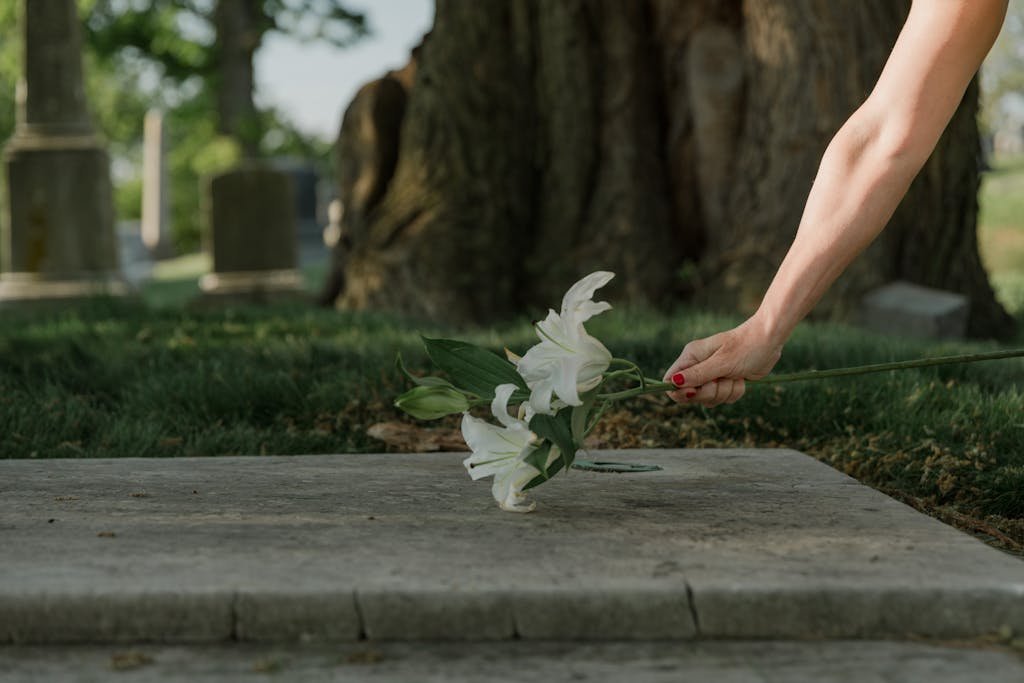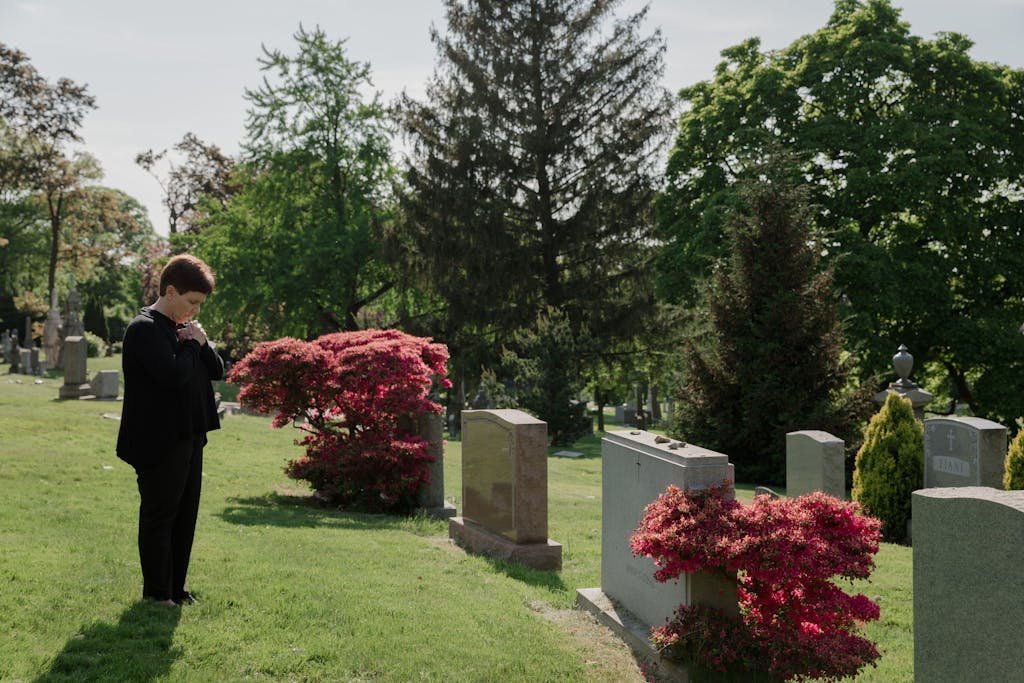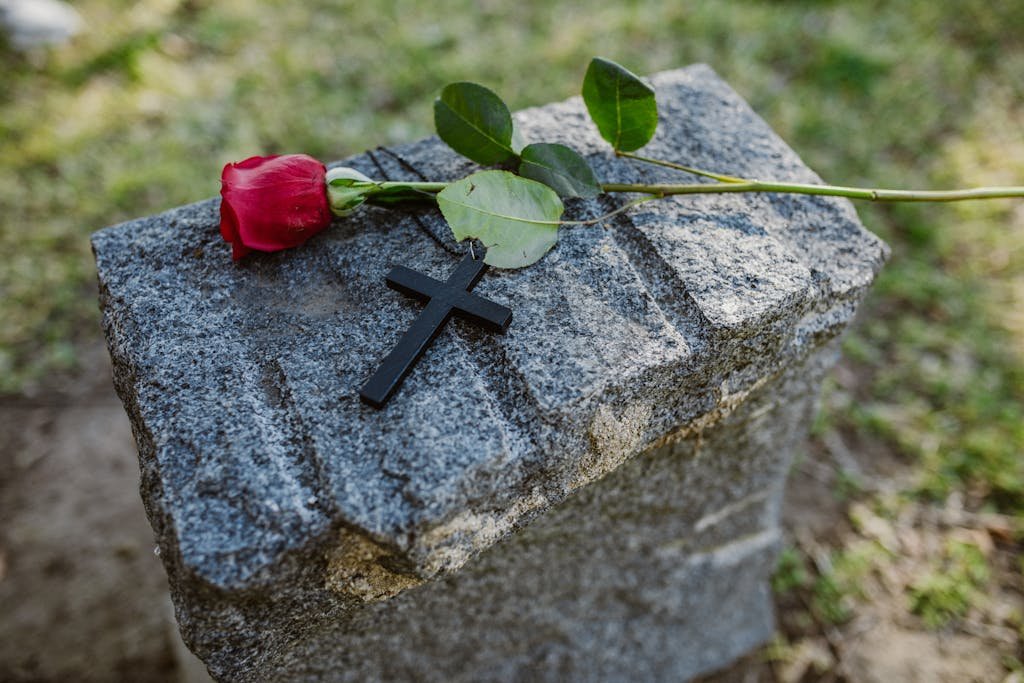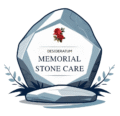What to Bring When Visiting a Grave
Visiting the grave of a loved one can be a meaningful act of remembrance and connection, but many people wonder: what to bring when visiting a grave? Whether you’re making your first visit to a family member’s gravesite or establishing a regular visiting routine, bringing appropriate items helps you honor their memory, maintain the grave site, and create a peaceful experience.
The items you bring depend on your purpose—some visits focus on quiet reflection, others on grave maintenance and decoration, and some combine both. Understanding what’s practical, what’s permitted, and what’s most meaningful helps you prepare for cemetery visits that feel right for you and respectful of the cemetery environment.
The Short Answer: What to bring when visiting a grave includes fresh flowers or weather-resistant decorations, basic cleaning supplies (soft brush, water, gentle cleaner), personal items like photos or mementos, and practical necessities like water for yourself, comfortable shoes, and sun protection. Always check individual cemetery rules about what decorations are permitted.

Essential Items to Bring When Visiting a Grave
Flowers and Decorations for Grave Visits
Fresh Flowers
Fresh flowers remain the most traditional and widely accepted grave decoration:
Best Fresh Flower Choices:
- Roses (classic, meaningful, long-lasting cut flowers)
- Carnations (durable, affordable, available year-round)
- Lilies (elegant, fragrant, symbolically meaningful)
- Chrysanthemums (fall favorite, long-lasting)
- Seasonal wildflowers (natural, connects to location)
Flower Containers:
- Bring vases if cemetery doesn’t provide built-in holders
- Weighted vases prevent tipping in wind
- Consider cemetery rules (some prohibit glass)
- Spike vases push into ground near headstone
- Cost: $5-20 for reusable cemetery vases
Fresh Flower Considerations: Fresh flowers require replacement every 1-2 weeks as they wilt. Many cemeteries remove dead flowers during maintenance, so expect your arrangements to be cleared periodically.
Artificial Flowers
Weather-resistant artificial flowers offer longevity:
Advantages:
- Last months or years without replacement
- No wilting or maintenance needed
- Year-round color and appearance
- Cost-effective long-term
- Work well for distant graves visited infrequently
Quality Matters: Invest in UV-resistant, outdoor-rated artificial flowers ($20-60 for quality arrangements). Cheap indoor artificial flowers fade and deteriorate quickly outdoors.
Cemetery Policies: Some cemeteries restrict or prohibit artificial flowers, particularly during certain seasons. Memorial Day through Labor Day may require fresh flowers only at some locations. Check with your specific cemetery—regulations vary widely according to the International Cemetery, Cremation and Funeral Association (https://www.iccfa.com).
Seasonal Decorations for Graves
Many families bring seasonal items:
Spring:
- Fresh spring bulb flowers
- Easter decorations (if permitted)
- Pastel ribbons
Summer:
- Bright summer flowers
- Small flags for Memorial Day (veterans)
- Solar lights
Fall:
- Chrysanthemums and fall foliage
- Small pumpkins or gourds (check rules)
- Autumn wreaths
Winter:
- Evergreen wreaths
- Winter flowers
- Holiday decorations (typically removed after season)
Seasonal Restriction Note: Most cemeteries remove seasonal decorations shortly after holidays. The National Cemetery Administration (https://www.cem.va.gov) removes decorations from VA national cemeteries according to published schedules to maintain grounds.
Prohibited Decorations
Common restrictions include:
Usually Not Allowed:
- Glass containers (breakage hazard)
- Balloons (become litter, blow away)
- Stuffed animals (weather damage, become unsightly)
- Breakable ceramics
- Food items (attract animals, create mess)
- Permanent plantings without permission
- Stakes or shepherds hooks (mowing hazards)
Cemetery maintenance crews need to mow and maintain grounds efficiently. Items that interfere with lawn care often get removed.
Grave Cleaning Supplies to Bring

Basic Cleaning Kit
Bringing cleaning supplies allows you to maintain the headstone during your visit:
Soft-Bristle Brush:
- Nylon or natural bristle brush
- Soft enough not to scratch stone
- Removes dirt, debris, biological growth
- Cost: $5-15 at hardware stores
Water:
- Bring in spray bottle or jug
- Distilled water preferable (no minerals)
- Tap water acceptable for basic cleaning
- 1-2 liters sufficient for most cleaning
Gentle Cleaning Solution: For stubborn dirt:
- Mild dish soap diluted in water (few drops per quart)
- D/2 Biological Solution (professional cleaner, available online)
- Never use: bleach, ammonia, acidic cleaners, pressure washers
Cloths or Sponges:
- Soft, non-abrasive cloths
- Microfiber works well
- Bring several for different cleaning stages
Small Container:
- Bucket or large container for mixing cleaning solution
- Collapsible camping bucket works well
- Can also use for collecting debris
Headstone cleaning services pricing covers professional cleaning costs, but family maintenance extends the time between professional services. Which type of headstone lasts the longest with proper care depends partly on regular gentle cleaning.
Gardening and Landscaping Supplies
If cemetery permits family maintenance:
Weeding Tools:
- Hand trowel or weeding tool
- Small gardening gloves
- Kneeling pad for comfort
- Bag for collecting pulled weeds
Trimming Supplies:
- Small pruning shears for overgrown plants
- Hedge trimmers for larger growth (check cemetery rules)
- Ground cover management tools
Caution: Many cemeteries handle all landscaping and prohibit family members from trimming, planting, or significantly altering grave sites. Verify policies before bringing extensive landscaping supplies.
Personal and Memorial Items to Bring When Visiting a Grave
Photographs
Bringing photos creates connection:
Types of Photos:
- Recent family photos to “share” with loved one
- Photos of important life events they missed
- Throwback photos from times together
- Photos of their great-grandchildren or other descendants
Weather Protection: If leaving photos at grave:
- Laminate photos to protect from weather
- Use weather-resistant frames
- Expect limited lifespan even with protection
- Consider taking photos with you after visit
Letters or Notes
Written messages can be therapeutic:
What People Write:
- Updates on family news
- Expressions of love and missing them
- Important life events shared
- Thoughts and feelings about loss
- Forgiveness or unresolved conversations
Handling:
- Some people read letters aloud at graveside
- Others place letters at grave (will be removed by cemetery maintenance)
- Some keep letters in personal journals
- No right or wrong approach
Meaningful Objects
Small mementos can be brought:
Appropriate Items:
- Stones or pebbles (Jewish tradition of placing stones on graves)
- Small religious items (rosary, prayer cards)
- Coins (military tradition at veterans’ graves)
- Flowers from your garden
- Objects connected to shared memories
What to Avoid:
- Valuable items (may be removed or stolen)
- Large objects
- Anything prohibited by cemetery rules
- Perishable food items
Religious or Spiritual Items
Depending on your faith tradition:
Prayer Items:
- Prayer books or religious texts
- Rosary beads
- Yahrzeit candles (where permitted—many cemeteries prohibit open flames)
- Religious cards or medals
- Incense (check cemetery policy)
Ritual Objects: Different traditions have specific practices:
- Jewish tradition: stones placed on headstones
- Catholic: Holy water, prayers for the dead
- Buddhist: incense, offerings (where permitted)
- Various traditions: specific flowers with symbolic meaning
Rules for visiting cemeteries vary by religious affiliation and local customs.
Practical Items to Bring When Visiting a Grave
Personal Comfort and Safety Supplies
Sun Protection: Cemetery visits often involve extended outdoor time:
Essential Sun Protection:
- Sunscreen (SPF 30+)
- Hat with brim
- Sunglasses
- Light long-sleeved shirt in summer
According to the Centers for Disease Control and Prevention (https://www.cdc.gov), extended outdoor exposure requires sun protection to prevent skin damage.
Weather-Appropriate Clothing:
- Comfortable walking shoes (cemeteries often have uneven terrain)
- Layers for changing temperatures
- Rain jacket if weather uncertain
- Warm clothing in winter
- Bug spray in humid climates or near wooded areas
Hydration:
- Bring water bottle, especially in warm weather
- Benches are common in cemeteries for rest breaks
- Stay hydrated during extended visits
Physical Comfort Items:
- Portable folding stool or chair
- Cushion or kneeling pad for grave-level work
- Umbrella for shade or rain
- Walking stick if terrain is challenging
Documentation and Navigation Tools
Cemetery Navigation:
Finding specific graves requires preparation:
Helpful Tools:
- Cemetery office directions to grave location
- Section and lot numbers written down
- Phone with GPS and maps
- Cemetery map (if provided)
- Photos of nearby landmarks or graves
How deep are graves and their spacing varies by cemetery, affecting ease of navigation.
Photography Equipment:
Many visitors photograph headstones:
For Genealogy:
- Camera or smartphone
- Portable phone charger
- Notebook for recording information
- Pen for notes
For Personal Memory:
- Take photos of decorated grave
- Document seasonal changes
- Capture overall cemetery setting
- Share with family unable to visit
Genealogical Research Tools:
When visiting for family history:
Research Supplies:
- Notebook and pens
- Grave marker details (names, dates, inscriptions)
- Nearby family graves to locate
- GPS to record exact locations
- Camera for documenting stones
Online Resources:
- Find A Grave or Billion Graves apps
- Family tree documentation
- Cemetery database access
Seasonal Considerations for What to Bring When Visiting a Grave
Spring and Summer Grave Visiting Supplies
Warm Weather Essentials:
- Extra water (for you and for cleaning headstone)
- Insect repellent (mosquitoes near vegetation)
- Sunscreen and hat
- Lighter decorations (won’t blow away in storms)
Spring-Specific:
- Fresh bulb flowers (tulips, daffodils)
- Soil amendments if cemetery allows planting
- Rain gear (spring showers)
Summer-Specific:
- Very early morning or evening visits (avoid midday heat)
- Ice packs in cooler for longer visits
- Extra sun protection
- Durable flowers that tolerate heat
Fall and Winter Grave Visiting Supplies
Cold Weather Essentials:
- Warm layers and gloves
- Insulated water bottle
- Hand warmers
- Ice/snow traction devices for shoes
Fall-Specific:
- Seasonal flowers (chrysanthemums)
- Rake for collecting fallen leaves from grave
- Fall wreaths
- Shorter visits due to early sunset
Winter-Specific:
- Heavier decorations (won’t blow away in winter winds)
- Evergreen arrangements
- Holiday decorations (removed after season)
- Snow brush if grave is snow-covered
Weather Safety: Winter cemetery visits require extra caution:
- Icy paths and uneven ground
- Shortened daylight hours
- Cold exposure risks
- Cemetery access may be limited in harsh weather
How long to wait before placing a headstone on a grave extends through winter in northern climates, so new graves may have only temporary markers during winter visits.
What NOT to Bring When Visiting a Grave
Items Typically Prohibited at Graves
Hazardous or Damaging Items:
- Glass containers (break and create hazards)
- Alcohol or drugs
- Fireworks or explosives
- Open flames in most cemeteries (fire hazard)
- Sharp objects left at grave
- Toxic chemicals
Disruptive Items:
- Loud music devices
- Sports equipment
- Pets in many cemeteries (service animals excepted)
- Vehicles off designated roads
- Bicycles or skateboards in some cemeteries
Prohibited Decorations: Cemetery-specific rules often ban:
- Permanent structures without approval
- Solar lights (at some cemeteries)
- Statuary or large ornaments
- Live plants or flowers (some allow only artificial)
- Balloons (environmental concern and litter)
- Pinwheels or wind chimes (maintenance interference)
Respectful Behavior Considerations
What Not to Do:
- Don’t bring large groups without consideration for other visitors
- Don’t bring food for picnics at graveside (some cemeteries prohibit)
- Don’t blast music even if meaningful to you
- Don’t allow children to run, play, or climb on monuments
- Don’t disturb decorations or items at neighboring graves
Cell Phone Etiquette:
- Silence ringers
- Keep conversations brief and quiet
- Photography is generally fine but be discreet
- No loud videos or FaceTime calls
According to cemetery management best practices published by the International Cemetery, Cremation and Funeral Association, maintaining peaceful atmosphere requires visitor cooperation.
Special Occasion Grave Visiting Supplies
Memorial Day and Veterans Day Grave Visits
Patriotic Decorations:
- American flags (standard for veterans’ graves)
- Red, white, and blue flowers
- Patriotic wreaths
- Small flag holders
Veterans-Specific Items:
- Service medals or replicas (don’t leave originals)
- Unit insignia
- Thank you notes from children
- Coins (military tradition: penny = visited, nickel = trained together, dime = served together, quarter = present at death)
The National Cemetery Administration provides flags for veterans’ graves on Memorial Day (https://www.cem.va.gov).
Birthday and Anniversary Grave Visits
Celebration Items:
- Birthday flowers or loved one’s favorite flowers
- Anniversary flowers (traditional anniversary flower types)
- Photos from happy occasions
- Letter sharing family updates
- Small birthday cake (if permitted and you’ll take with you—don’t leave food)
Holiday Grave Visiting Supplies
Christmas/Hanukkah/Winter Holidays:
- Evergreen wreaths
- Holiday flowers (poinsettias, winter arrangements)
- Religious decorations (within cemetery rules)
- Battery-operated lights (where permitted)
Note: Most cemeteries remove holiday decorations in January. Don’t be surprised if wreaths and holiday items are cleared away after the season.
Easter:
- Spring flowers
- Easter lilies
- Pastel-colored decorations
- Religious symbols (crosses, angels)
Other Cultural Holidays:
- Dia de los Muertos (marigolds, photos, favorite foods in areas where permitted)
- All Souls Day (candles where permitted, flowers, prayers)
- Cultural-specific memorial days
Creating a Grave Visiting Kit
Assembling Your Cemetery Visiting Supplies
Portable Kit Container:
- Large tote bag or bin
- Keeps supplies organized
- Easy to grab for cemetery visits
- Waterproof container preferred
Basic Kit Contents:
- Soft-bristle brush
- Spray bottle for water
- Mild cleaning solution
- Soft cloths
- Small hand trowel
- Gardening gloves
- Plastic bags for debris
- Vase or flower holders
- Sunscreen and bug spray
- Water bottle
- Notebook and pen
Seasonal Additions:
- Rotate seasonal decorations
- Adjust for weather (winter gloves, summer hat)
- Update as needed
Car Storage: Keep basic kit in car if you visit regularly:
- Always prepared for spontaneous visits
- Supplies ready when you pass cemetery
- No planning required for impromptu visits
Cemetery-Specific Rules About What to Bring When Visiting a Grave
Researching Your Cemetery’s Policies
Finding Information:
- Cemetery website (many list rules and policies)
- Posted signs at cemetery entrance
- Cemetery office (call for specific questions)
- Printed rule handouts available at office
Common Restrictions: Every cemetery differs, but common policies include:
Flower Restrictions:
- Fresh only during certain seasons
- No artificial flowers at some locations
- Only cemetery-approved containers
- Removal schedule for dead flowers
Decoration Limitations:
- Size limits on decorations
- Approved materials only
- Seasonal item removal dates
- Permanent decoration approval process
Maintenance Restrictions:
- No family landscaping allowed
- No painting or altering headstones
- No digging or excavation
- Professional services required for repairs
What happens to graves after 100 years includes discussion of cemetery maintenance responsibilities, which influence what families can do.
Understanding Enforcement
Decoration Removal: Cemetery staff regularly remove:
- Dead or wilted flowers
- Prohibited items
- Seasonal decorations after season
- Anything interfering with maintenance
Why Items Disappear: It’s not personal—cemeteries must:
- Maintain professional appearance
- Facilitate lawn maintenance
- Prevent pest problems
- Comply with regulations
- Keep grounds safe and tidy
Communication: If items are consistently removed:
- Verify they’re permitted
- Ask cemetery for specific policies
- Adjust what you bring accordingly
- Work with cemetery rather than against policies
Emotional and Spiritual Items to Bring When Visiting a Grave
Personal Reflection Tools
Journal or Notebook: Some visitors find writing therapeutic:
- Write feelings, memories, or messages
- Private processing of grief
- Track thoughts over time
- No need to leave at grave
Religious or Spiritual Texts: Reading meaningful passages:
- Bible, Torah, Quran, or other sacred texts
- Poetry collections
- Favorite readings of deceased
- Prayers or liturgies
Meditation Tools: For contemplative visits:
- Prayer beads or rosary
- Meditation cushion or pad
- Mindfulness apps or timers
- Peaceful music (headphones)
Memorial Traditions from Various Cultures

Diverse Practices: Different cultures bring specific items:
Jewish Traditions:
- Stones to place on headstone (widespread practice)
- Prayer books
- Yahrzeit candles (at home, not cemetery)
Catholic Traditions:
- Holy water
- Prayer cards
- Rosary beads
- Fresh flowers (especially Easter lilies, chrysanthemums)
Asian Traditions:
- Incense (where permitted)
- Favorite foods of deceased (often removed after visit)
- Paper offerings in some traditions
- Specific seasonal items
Hispanic Traditions:
- Bright flowers (especially marigolds)
- Photos of deceased
- Religious items
- Family gathering supplies for extended visits
Cultural practices vary widely. Respect others’ traditions when visiting shared cemetery spaces. Can you visit any cemetery regardless of cultural background, but understanding diverse practices enriches the experience.
Common Questions About What to Bring When Visiting a Grave
Can you bring plants to a cemetery?
Most cemeteries prohibit live plants unless planted in designated areas with approval. Some allow small potted plants temporarily. Permanent plantings typically require cemetery permission and may incur fees. Artificial plants are often better for long-term decoration.
Is it okay to bring toys to a child’s grave?
Many cemeteries understand parents’ desire to bring toys to children’s graves. However, stuffed animals and plastic toys deteriorate quickly outdoors and may be removed during maintenance. Check cemetery policy—some permit, others restrict toys. Weather-resistant items last longer.
Can you bring food or drinks to a cemetery?
For your own consumption, water and simple snacks are usually fine. Leaving food at graves is typically prohibited (attracts animals, creates mess). Some cultures leave food offerings, but most cemeteries remove these items quickly. Check specific cemetery rules.
What if the cemetery removes things I bring?
Cemeteries maintain grounds by removing dead flowers, prohibited items, and seasonal decorations past season. This is normal maintenance, not disrespect. Verify cemetery rules and adjust what you bring accordingly. Focus on items permitted for longer-term placement.
How often should you bring new flowers?
Fresh flowers last 1-2 weeks typically. Visit frequency varies by family—some visit weekly, others monthly, seasonally, or on special occasions only. There’s no “should”—visit and bring items as often as feels right for you and your circumstances.
Can you bring pets to cemeteries?
Most cemeteries prohibit pets (except service animals) due to potential disturbance, sanitation concerns, and respect for other visitors. Some pet cemeteries or pet sections of regular cemeteries allow pets. Verify policy before bringing animals.
What’s the best time to visit a grave?
Cemeteries typically open dawn to dusk. Best times depend on preference: early morning is peaceful with few visitors, weekday mornings avoid crowds, late afternoon offers beautiful light for photos. Avoid visiting during active funeral services in the area.
The Bottom Line on What to Bring When Visiting a Grave
What to bring when visiting a grave ultimately depends on your personal needs, the deceased’s preferences, cemetery regulations, and your visit’s purpose. At minimum, bring respect, quiet contemplation, and appropriate behavior. Beyond that, fresh flowers, basic cleaning supplies, personal comfort items, and meaningful mementos enhance the experience.
The most important thing you bring to a grave is yourself—your presence, memories, and continued connection to the person you’ve lost. How much does it cost to be buried matters to families creating these spaces, but visiting and maintaining graves costs primarily time and care rather than money.
Do you have to be embalmed and other burial decisions happen once, but visiting is an ongoing choice that keeps connections alive. Whether you bring elaborate flowers, simple stones, or just yourself, the act of visiting honors your loved one’s memory and provides solace during grief.
Start with basics—flowers, water, cleaning brush, and comfortable walking shoes. Over time, you’ll develop your own visiting routine, learning what items are meaningful to you, what the cemetery permits, and what helps you feel connected to the person whose life you’re honoring through your visit.
